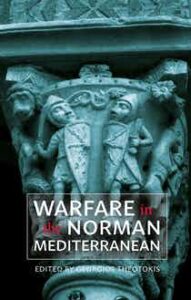Georgios Theotokis (ed.)
Warfare in the Norman Mediterranean
(Boydell & Brewer, 2020), 252 pp. $99.00

Historians, even medieval historians, have their stars. These are peoples, things, ideas, movements that somehow we cannot leave alone. The Vikings, cultural renaissances, military revolutions, we keep returning to them all. And amongst these none have more star quality than the Normans. From the Baltic to the British Isles, to the islands of the Atlantic and even North America, Sicily, Byzantium and even the Holy Land, wherever we look we encounter the Normans. They march like giants across our consciousness, embedded there by a galaxy of chroniclers who praised and damned them for all their worth, but could never ignore them.
This collection of papers, therefore, takes its place in a vast body of literature, but it has a very tight focus on military aspects of the Norman expansion in the Mediterranean. In view of the title it is a pity that there is no consideration of the Normans in Byzantium before the First Crusade, or their presence, albeit very limited, in Spain. However, the editor has brought together an interesting set of essays which have a close focus on warfare, and he has grouped them into sensible categories. Part I is dedicated to a discussion of the sources. Georgios Theotokis’ own contribution is on the Greek and Latin sources for the Normans in the south. He notes that ‘There is a scarcity of narrative sources in Greek that detail the gradual decline of Byzantine power in Italy’ (13), so what follows is a discussion of the Latin accounts from a military viewpoint. In fact, as he says, they have quite a lot to offer on directly military matters, though subject to the (very) usual limitations on numbers and clear descriptions of military events. Francesca Petrizzo provides a highly original and fascinating study of the three main sources for the Normans in Italy, Amatus of Montecassino, William of Apulia and Geoffrey Malaterra. She challenges what she describes as a carefully cultivated picture of ‘a ragtag band of desperate people, lost in a hostile landscape’ (36) struggling through dangers, and eventually ‘validated by God’s plan for the Normans in Italy’ (53). Instead, she suggests, the Hautevilles planned carefully and were reasonably resourced. James Titterton looks at Guiscard’s reputation for trickery through the lens of the sources for the Normans in the south and the Gesta Tancredi, whose literary quality he brings out very well.
In Part 2 David Nicolle offers a striking analysis of the Sicilian Muslim military tradition, with particular emphasis on the weaponry and armour which is illustrated in his usual excellent style (110-31). He records the degree to which Muslim mercenaries from Sicily were employed by the Normans and others, right through to the 13th century. This is another fragment of evidence against the idea of a ‘Clash of Civilizations’ which has so haunted discussion of the crusades and, indeed, European history generally. Matthew Bennet catalogues the fighting method and tactics of the Normans as used against their various enemies in the Mediterranean world. S.V. Marin presents a striking original discussion of Venetian attitudes to the Normans based on Venetian source material which is not at all well known to historians, but which is obviously rich and important.
In Part 3 Charles Stanton offers a lively and perceptive discussion of Sicilian Norman naval power in the twelfth century. This broad topic is continued more specifically by M.S. Fulton who argues convincingly that the famously abortive Sicilian-Norman raid on Alexandria in 1174 should be seen as a raid rather than a failed contribution to the Latin Kingdom of Jerusalem’s efforts to control Egypt. Daniel Franke explores the vexed question of the place of the Norman conquests in the south in papal thinking about holy war, notably dismissing the notion that it was a major influence upon Urban II. This an interesting preliminary exploration, but of a huge topic which Franke enlightens with some useful comment on the nature of strategy. The essay by Luigi Russo is essentially a discussion of the Norman participation in the First Crusade. He thinks that the relatively small number and low status of those who accompanied Bohemond suggests a lack of enthusiasm for the crusade. Matching this is the fact that when he wanted to recruit for his attack on Byzantium in 1105-07 Bohemond went to France, arousing little attention in Italy. This is fascinating stuff for any exploration of the origins of the First Crusade which to often is centred on France. With regard to the limited interest in Bohemond’s expedition to Byzantium, one wonders about the impact on attitudes of the failure of the Crusade of 1101 in which Italians participated on a large scale.
A recurrent question in these essays is what is strategy and how far is it a useful concept in evaluating events in the 11th and 12th centuries? Did Pope Urban have anything that can be described as a strategy, or was he simply a man with ambitions? This is perhaps a topic tangential to this volume. However, all the contributors have rather different approaches to strategy, and Franke’s essay notably tackles the subject head-on though without any definitive result – entirely understandably.
This is a very well-produced volume with an impressive range of pictures, a combined Bibliography and a useful index. Its content is a tribute to its editor Georgios Theotokis who had brought to press yet another study of the Normans.
John France
Swansea University
